“We are proud of what we were able to achieve with the Downtown/Chinatown component of the project. In only three months we not only completed data collection and traffic analysis at 12 intersections but were able to engage hundreds of stakeholders to gather input on the project and generate awareness and support for Complete Streets in general.” Melissa White
Implementing Complete Streets in Downtown/Chinatown
Where the Rubber Meets the Road
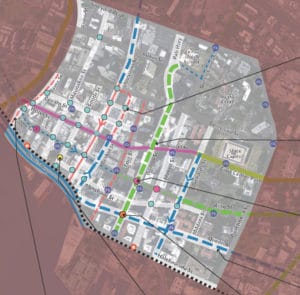 By Melissa White, AICP
By Melissa White, AICP
In 2009, Hawaii passed a law requiring complete streets policies for counties that will make streets, sidewalks and neighborhoods safe and inviting for users of all ages and abilities.
In 2016, the City and County of Honolulu finalized its Complete Streets Design Manual and hired a Complete Streets Program Administrator. Since then, the City has been working to implement Complete Streets by updating policies, adopting guidelines, and applying these principles in all aspects of work. Planned roadway rehabilitation projects for Downtown and Chinatown over the next 2 to 4 years offer an outstanding opportunity to accelerate Complete Streets by incorporating pedestrian safety and bicycle network improvements. Improvements will range from pavement markings for bike lanes, bulbouts to extend sidewalks and improve pedestrian visibility, raised medians, and protected intersections that separate bicycle, pedestrian, and vehicle traffic.

SSFM has had the opportunity to steward the process of design and review of solutions that will be incorporated into the Chinatown improvement plans. “We are proud of what we were able to achieve with the Downtown/Chinatown component of the project. In only three months we not only completed data collection and traffic analysis at 12 intersections but were able to engage hundreds of stakeholders to gather input on the project and generate awareness and support for Complete Streets in general. The maps, online platforms and educational materials we developed for the project will endure and continue to be used in promoting Honolulu Complete Streets. It was a herculean effort for such a short time frame, and the team that came together to make it happen felt a lot of camaraderie and a great sense of accomplishment.” SSFM met the challenge of managing a complex process that entailed more than two dozen neighborhood and community meetings, communicating findings and assimilating feedback in an especially accelerated time frame.
Of SSFM’s effort, Mike Packard, Honolulu’s Complete Streets Program Administrator offered the following acknowledgement.
“Thank you for the hard work the SSFM team put into making this project a reality. What you pulled off in a short 3 months was extraordinary. The presentation, response at the meeting and people’s expression of appreciation were made possible because of your close relationships in the community, and your ability to connect with total strangers and make them feel heard. This project sets an incredibly high bar for what a true context sensitive project entails. Thanks to the SSFM team for an incredibly time intensive couple of months and to your leadership for enabling you to do this on such quick notice.”
We are grateful to Mike and the City leaders for this important opportunity and their confidence in our capabilities.
Solutions are designed to accommodate pedestrians, bicyclists, drivers, and public transit users. It recognizes streets and streetscapes as strategic public environments that transcend simply moving people. A successful Complete Street design will benefit the social and economic environment of a city.
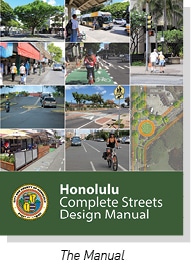 The components of the Manual which include street types, travel ways, intersections, pedestrian crossings, bicycle facilities, pedestrian zones, and street ecosystems, are readily transferable to both urban and rural settings. The Manual is customized for Honolulu and prescribes planning, design, construction, operations and maintenance criteria for transportation facilities and projects. As an open source resource, it is available to anyone and can be tailored to specific project requirements.
The components of the Manual which include street types, travel ways, intersections, pedestrian crossings, bicycle facilities, pedestrian zones, and street ecosystems, are readily transferable to both urban and rural settings. The Manual is customized for Honolulu and prescribes planning, design, construction, operations and maintenance criteria for transportation facilities and projects. As an open source resource, it is available to anyone and can be tailored to specific project requirements.
The Manual is designed to be easy to use. It relies heavily on local photographs to demonstrate models for successful Complete Streets. Graphics depict cross-sections that can accommodate pedestrians, bicycles, buses, landscaping, and rail. Criteria presented in the Manual protect the integrity of the natural environment and the heritage of the built environment while expanding mobility choices and opportunities for everyone with special focus on making pedestrian environments universally accessible.
Honolulu regularly appears among the cities with the worst traffic congestion and tops the list of elderly pedestrian deaths. The Manual places particular emphasis on solutions to mitigate these problems by presenting practical designs to reconfigure streets. Multimodal transportation options that incorporate safe and engaging streets encourage people to shift transit modes. Increased bicycle use is evidence of this trend. The Complete Streets program promotes this movement with bike share stations and dedicated bicycle facilities.
The Manual looks at implementation policy and principles for ten planning objectives.
- Improve safety.
- Apply a location sensitive solution process that integrates community context and land use, and the surrounding environment.
- Protect and promote accessibility and mobility for all users.
- Balance the needs and comfort of all modes and users.
- Encourage consistent use of national industry best practice guidelines for complete streets design elements.
- Improve energy efficient travel and mitigate vehicle emissions through non-motorized transportation options.
- Encourage physical activity and recognize the health benefits of an active lifestyle.
- Embrace Complete Streets as a long-term investment that will save money over time.
- Build partnerships with stakeholders and organizations statewide.
- Incorporate trees and landscaping as integral components of Complete Streets.
The Manual addresses the Streetscape Ecosystem with recommendations and solutions to manage stormwater on-site with technologically advanced, yet practical and easy to implement, solutions. Guidance is provided for street tree maintenance and to clearly define private and public roles. The Manual team is planning based and has incorporated policies and best practice concepts for sustainability, low impact development (LID), healthy cities and smart growth.
Nowhere is the concept of universal access more important than in the design of sidewalks. The social and economic context of streets serve as the basis for design. The Design Manual includes well-defined guidelines for sidewalks that accommodates pedestrians of all ages and physical abilities. Inviting pedestrian environments in commercial areas, in turn, have a positive impact on the economy. The Manual provides direction for different types of streets and adjacent land uses and neighborhoods.
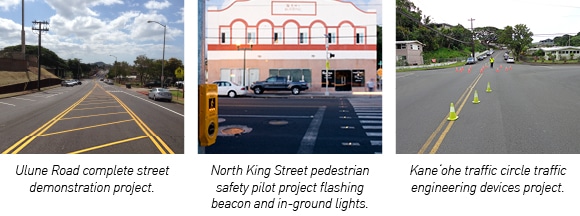
A Collaborative Process
Integration of transportation planning and community planning is key to the success of the Complete Streets program. The Manual provides addresses compatibility ad adherence to the legal provisions of Section 264-20.5, Hawaii Revised Statutes (Act 54 SLH 2009) and City and County of Honolulu Ordinance 12-15. The Manual’s context sensitive, multi-modal approach recognizes existing conditions, history, and resource constraints. It acknowledges that rights-of-ways consume considerable land and impact the City’s economy. Streets are conduits to commercial areas and are primarily places from which residents and visitors experience the city. Streets are fundamental to the economy.
The Complete Streets Design Manual through an intensive and collaborative process and partnerships that engaged engineers and planners from twelve city agencies, and input from four State agencies, AARP, Hawaii Bicycling League, and several Neighborhood Boards. Multi-day workshops were used to customize and modify design elements for conditions in Honolulu.

Many stakeholders had a role in the Manual’s development. Between Mayor Caldwell’s age-friendly City initiative and public outcry at traffic congestion and pedestrian accidents, citizens and non-profit organizations readily came forward to offer their concerns and recommendations. Issues, energy and insight was captured during walk audits and community workshops resulted in design standards that truly respond to citizens’ needs.
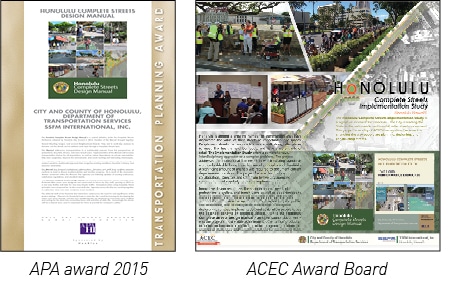 Honored for Excellence
Honored for Excellence
The Manual and Complete Streets Implementation Study has received awards for excellence in transportation planning and honor in engineering from the Hawaii chapter of the American Planning Association and the American Council of Engineering Companies.
On-Going Results
The Manual has garnered institutional collaboration. Directors and staff from twelve city agencies continue to meet regularly to discuss implementation. City agencies are initiating updates of existing ordinances, codes, subdivision standards, and plans. The Manual is yielding results.
The King Street Protected Bike Lanes, opened as a one way facility and has since expanded to accommodate two way bicycle use. Over a dozen complete street site-specific projects are in conceptual planning design. Local advocacy organizations have been critical in the City’s prioritization of pedestrian and bicyclists’ needs.
The Honolulu Complete Streets Implementation Study has also established performance measures based on responsiveness, clarity, usefulness, relevance, measurability, scale, temporal quality and public satisfaction.
SSFM was part of a multi-discipline team of volunteers and stakeholders providing the planning, design, and construction of an all-day complete street demonstration along a 1.5 mile stretch of road in Kakaako as a part of the Hele On Kakaako Cyclovia. The demonstration showcased the benefits of a complete street, creating a balanced transportation system that can produce economic growth and stability.
As a part of the Traffic Engineering Devices at Various Locations project with the City, SSFM created designs for the construction of three demonstration projects on Oahu that showcased the ability to implement Complete Streets at low cost, and in collaboration with different stakeholders including private developers, schools, and emergency responders.
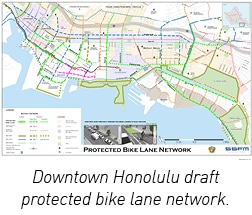 Another initiative evolving from the Complete Streets program, as part of the City’s Multimodal Bike Study, are plans for a 1/2-mile grid network of protected bike lanes in the downtown core. This includes the installation a 1/2-mile stretch of protected bike lanes on South Street to provide a bicycle connection. This provides a bicycle connection between the King Street protected bike lanes, Alapai Transit Center, the City Civic Center, the future site of the Honolulu Rail Civic Center Station, and development in Kakaako. This SSFM led project will add to Honolulu’s progressive implementation program for Complete Streets.
Another initiative evolving from the Complete Streets program, as part of the City’s Multimodal Bike Study, are plans for a 1/2-mile grid network of protected bike lanes in the downtown core. This includes the installation a 1/2-mile stretch of protected bike lanes on South Street to provide a bicycle connection. This provides a bicycle connection between the King Street protected bike lanes, Alapai Transit Center, the City Civic Center, the future site of the Honolulu Rail Civic Center Station, and development in Kakaako. This SSFM led project will add to Honolulu’s progressive implementation program for Complete Streets.
Implementing Complete Streets in Downtown/Chinatown
Where the Rubber Meets the Road…
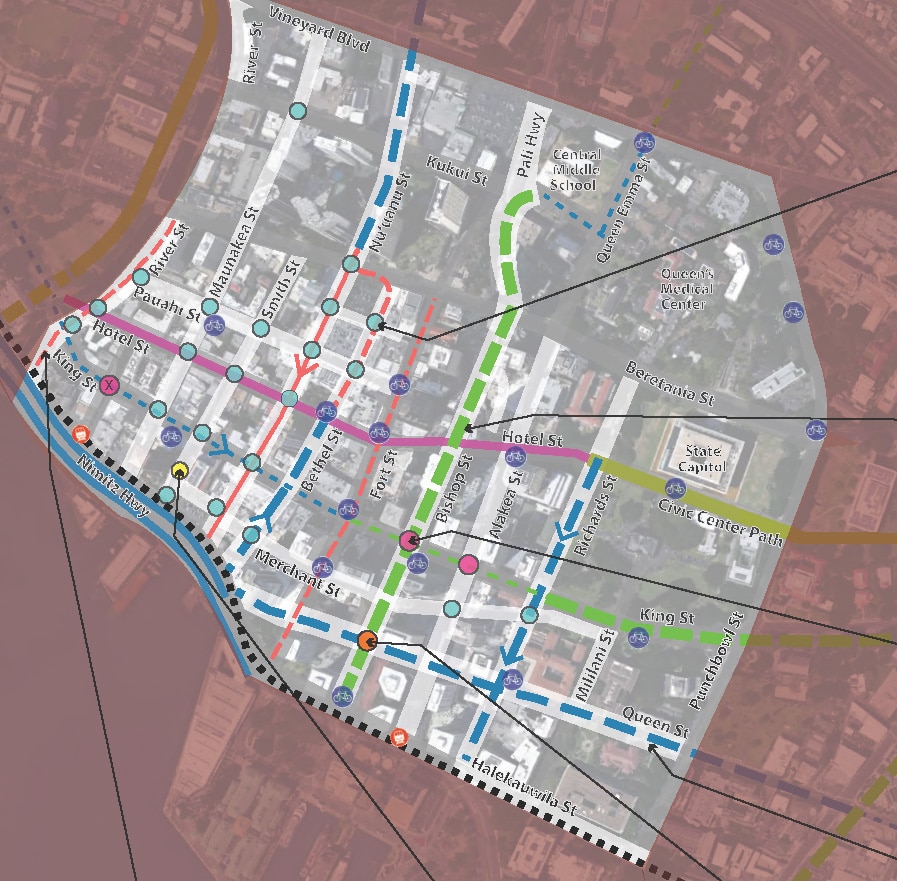
By Melissa White, AICP
In 2009, Hawaii passed a law requiring complete streets policies for counties that will make streets, sidewalks and neighborhoods safe and inviting for users of all ages and abilities.
In 2016, the City and County of Honolulu finalized its Complete Streets Design Manual and hired a Complete Streets Program Administrator. Since then, the City has been working to implement Complete Streets by updating policies, adopting guidelines, and applying these principles in all aspects of work. Planned roadway rehabilitation projects for Downtown and Chinatown over the next 2 to 4 years offer an outstanding opportunity to accelerate Complete Streets by incorporating pedestrian safety and bicycle network improvements. Improvements will range from pavement markings for bike lanes, bulbouts to extend sidewalks and improve pedestrian visibility, raised medians, and protected intersections that separate bicycle, pedestrian, and vehicle traffic.

By Melissa White, AICP
In 2009, Hawaii passed a law requiring complete streets policies for counties that will make streets, sidewalks and neighborhoods safe and inviting for users of all ages and abilities.
In 2016, the City and County of Honolulu finalized its Complete Streets Design Manual and hired a Complete Streets Program Administrator. Since then, the City has been working to implement Complete Streets by updating policies, adopting guidelines, and applying these principles in all aspects of work. Planned roadway rehabilitation projects for Downtown and Chinatown over the next 2 to 4 years offer an outstanding opportunity to accelerate Complete Streets by incorporating pedestrian safety and bicycle network improvements. Improvements will range from pavement markings for bike lanes, bulbouts to extend sidewalks and improve pedestrian visibility, raised medians, and protected intersections that separate bicycle, pedestrian, and vehicle traffic.
More / Less

SSFM has had the opportunity to steward the process of design and review of solutions that will be incorporated into the Chinatown improvement plans. “We are proud of what we were able to achieve with the Downtown/Chinatown component of the project. In only three months we not only completed data collection and traffic analysis at 12 intersections but were able to engage hundreds of stakeholders to gather input on the project and generate awareness and support for Complete Streets in general. The maps, online platforms and educational materials we developed for the project will endure and continue to be used in promoting Honolulu Complete Streets. It was a herculean effort for such a short time frame, and the team that came together to make it happen felt a lot of camaraderie and a great sense of accomplishment.” SSFM met the challenge of managing a complex process that entailed more than two dozen neighborhood and community meetings, communicating findings and assimilating feedback in an especially accelerated time frame.
Of SSFM’s effort, Mike Packard, Honolulu’s Complete Streets Program Administrator offered the following acknowledgement.
“Thank you for the hard work the SSFM team put into making this project a reality. What you pulled off in a short 3 months was extraordinary. The presentation, response at the meeting and people’s expression of appreciation were made possible because of your close relationships in the community, and your ability to connect with total strangers and make them feel heard. This project sets an incredibly high bar for what a true context sensitive project entails. Thanks to the SSFM team for an incredibly time intensive couple of months and to your leadership for enabling you to do this on such quick notice.”
We are grateful to Mike and the City leaders for this important opportunity and their confidence in our capabilities.
Solutions are designed to accommodate pedestrians, bicyclists, drivers, and public transit users. It recognizes streets and streetscapes as strategic public environments that transcend simply moving people. A successful Complete Street design will benefit the social and economic environment of a city.
 The components of the Manual which include street types, travel ways, intersections, pedestrian crossings, bicycle facilities, pedestrian zones, and street ecosystems, are readily transferable to both urban and rural settings. The Manual is customized for Honolulu and prescribes planning, design, construction, operations and maintenance criteria for transportation facilities and projects. As an open source resource, it is available to anyone and can be tailored to specific project requirements.
The components of the Manual which include street types, travel ways, intersections, pedestrian crossings, bicycle facilities, pedestrian zones, and street ecosystems, are readily transferable to both urban and rural settings. The Manual is customized for Honolulu and prescribes planning, design, construction, operations and maintenance criteria for transportation facilities and projects. As an open source resource, it is available to anyone and can be tailored to specific project requirements.
The Manual is designed to be easy to use. It relies heavily on local photographs to demonstrate models for successful Complete Streets. Graphics depict cross-sections that can accommodate pedestrians, bicycles, buses, landscaping, and rail. Criteria presented in the Manual protect the integrity of the natural environment and the heritage of the built environment while expanding mobility choices and opportunities for everyone with special focus on making pedestrian environments universally accessible.
Honolulu regularly appears among the cities with the worst traffic congestion and tops the list of elderly pedestrian deaths. The Manual places particular emphasis on solutions to mitigate these problems by presenting practical designs to reconfigure streets. Multimodal transportation options that incorporate safe and engaging streets encourage people to shift transit modes. Increased bicycle use is evidence of this trend. The Complete Streets program promotes this movement with bike share stations and dedicated bicycle facilities.
The Manual looks at implementation policy and principles for ten planning objectives.
- Improve safety.
- Apply a location sensitive solution process that integrates community context and land use, and the surrounding environment.
- Protect and promote accessibility and mobility for all users.
- Balance the needs and comfort of all modes and users.
- Encourage consistent use of national industry best practice guidelines for complete streets design elements.
- Improve energy efficient travel and mitigate vehicle emissions through non-motorized transportation options.
- Encourage physical activity and recognize the health benefits of an active lifestyle.
- Embrace Complete Streets as a long-term investment that will save money over time.
- Build partnerships with stakeholders and organizations statewide.
- Incorporate trees and landscaping as integral components of Complete Streets.
The Manual addresses the Streetscape Ecosystem with recommendations and solutions to manage stormwater on-site with technologically advanced, yet practical and easy to implement, solutions. Guidance is provided for street tree maintenance and to clearly define private and public roles. The Manual team is planning based and has incorporated policies and best practice concepts for sustainability, low impact development (LID), healthy cities and smart growth.
Nowhere is the concept of universal access more important than in the design of sidewalks. The social and economic context of streets serve as the basis for design. The Design Manual includes well-defined guidelines for sidewalks that accommodates pedestrians of all ages and physical abilities. Inviting pedestrian environments in commercial areas, in turn, have a positive impact on the economy. The Manual provides direction for different types of streets and adjacent land uses and neighborhoods.

A Collaborative Process
Integration of transportation planning and community planning is key to the success of the Complete Streets program. The Manual provides addresses compatibility ad adherence to the legal provisions of Section 264-20.5, Hawaii Revised Statutes (Act 54 SLH 2009) and City and County of Honolulu Ordinance 12-15. The Manual’s context sensitive, multi-modal approach recognizes existing conditions, history, and resource constraints. It acknowledges that rights-of-ways consume considerable land and impact the City’s economy. Streets are conduits to commercial areas and are primarily places from which residents and visitors experience the city. Streets are fundamental to the economy.
The Complete Streets Design Manual through an intensive and collaborative process and partnerships that engaged engineers and planners from twelve city agencies, and input from four State agencies, AARP, Hawaii Bicycling League, and several Neighborhood Boards. Multi-day workshops were used to customize and modify design elements for conditions in Honolulu.

Many stakeholders had a role in the Manual’s development. Between Mayor Caldwell’s age-friendly City initiative and public outcry at traffic congestion and pedestrian accidents, citizens and non-profit organizations readily came forward to offer their concerns and recommendations. Issues, energy and insight was captured during walk audits and community workshops resulted in design standards that truly respond to citizens’ needs.
 Honored for Excellence
Honored for Excellence
The Manual and Complete Streets Implementation Study has received awards for excellence in transportation planning and honor in engineering from the Hawaii chapter of the American Planning Association and the American Council of Engineering Companies.
On-Going Results
The Manual has garnered institutional collaboration. Directors and staff from twelve city agencies continue to meet regularly to discuss implementation. City agencies are initiating updates of existing ordinances, codes, subdivision standards, and plans. The Manual is yielding results.
The King Street Protected Bike Lanes, opened as a one way facility and has since expanded to accommodate two way bicycle use. Over a dozen complete street site-specific projects are in conceptual planning design. Local advocacy organizations have been critical in the City’s prioritization of pedestrian and bicyclists’ needs.
The Honolulu Complete Streets Implementation Study has also established performance measures based on responsiveness, clarity, usefulness, relevance, measurability, scale, temporal quality and public satisfaction.
SSFM was part of a multi-discipline team of volunteers and stakeholders providing the planning, design, and construction of an all-day complete street demonstration along a 1.5 mile stretch of road in Kakaako as a part of the Hele On Kakaako Cyclovia. The demonstration showcased the benefits of a complete street, creating a balanced transportation system that can produce economic growth and stability.
As a part of the Traffic Engineering Devices at Various Locations project with the City, SSFM created designs for the construction of three demonstration projects on Oahu that showcased the ability to implement Complete Streets at low cost, and in collaboration with different stakeholders including private developers, schools, and emergency responders.
 Another initiative evolving from the Complete Streets program, as part of the City’s Multimodal Bike Study, are plans for a 1/2-mile grid network of protected bike lanes in the downtown core. This includes the installation a 1/2-mile stretch of protected bike lanes on South Street to provide a bicycle connection. This provides a bicycle connection between the King Street protected bike lanes, Alapai Transit Center, the City Civic Center, the future site of the Honolulu Rail Civic Center Station, and development in Kakaako. This SSFM led project will add to Honolulu’s progressive implementation program for Complete Streets.
Another initiative evolving from the Complete Streets program, as part of the City’s Multimodal Bike Study, are plans for a 1/2-mile grid network of protected bike lanes in the downtown core. This includes the installation a 1/2-mile stretch of protected bike lanes on South Street to provide a bicycle connection. This provides a bicycle connection between the King Street protected bike lanes, Alapai Transit Center, the City Civic Center, the future site of the Honolulu Rail Civic Center Station, and development in Kakaako. This SSFM led project will add to Honolulu’s progressive implementation program for Complete Streets.
Category:
Complete Streets
